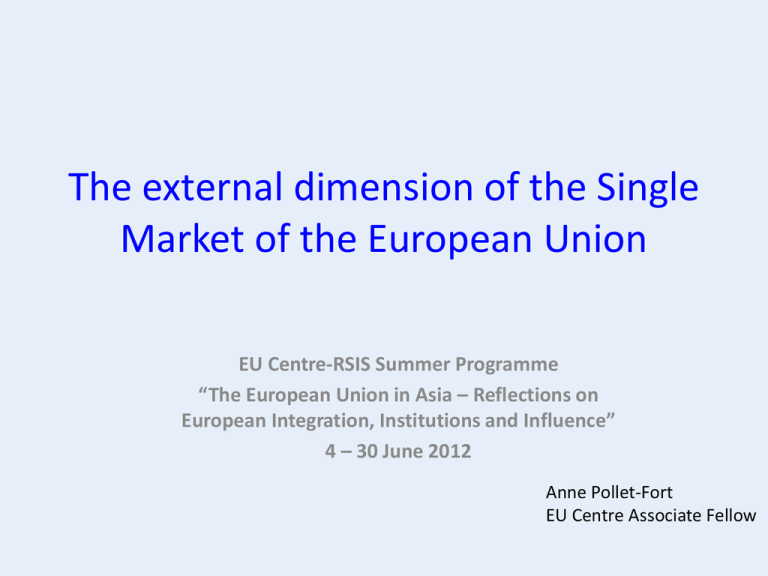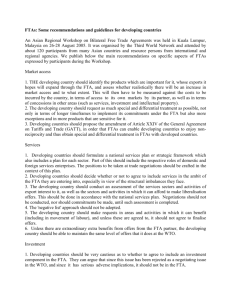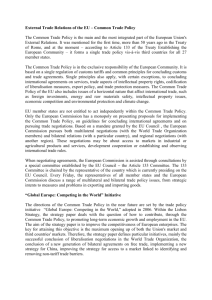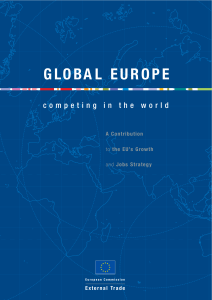Trade policy - EU Centre in Singapore
advertisement

The external dimension of the Single Market of the European Union EU Centre-RSIS Summer Programme “The European Union in Asia – Reflections on European Integration, Institutions and Influence” 4 – 30 June 2012 Anne Pollet-Fort EU Centre Associate Fellow Introduction • Originally, internal dimension of single market dominated over external dimension (inwardlooking attitude) • External partners placed the external dimension of Single Market on political agenda – Concerns over impact of SM and formation of “Fortress Europe” • Europe response • SM should be open to 3rd countries • EU will seek greater liberalisation of international trade The EU, a major trading partner • • • • 16.8% of world trade in 2010 First exporter (16.2% in 2010) Largest importer (17.3% in 2010) Leader in Foreign Direct Investment – EU-27 receives € 218.7 bn in 2010 • Main trading partners – USA, China, Russia, Switzerland – Canada (11th), Singapore (12th), Indonesia (33rd), Bangladesh (48th) The EU Trade Policy Competence, decision-making and instruments Competence • External trade policy is an exclusive European competence – MS are precluded to conclude individual trade policies – EU institutions competent to adopt EU trade legislation and enter into bilateral or multilateral trade agreements • However, European competence depends on definition of scope of EU external trade policy – Since 1958, scope of EU competence has changed several times and was subject of debates between EU and MS – Lisbon Treaty clarifies the EU competence. All key aspects of trade, goods & services, trade related aspects of intellectual property & FDI fall under exclusive competence of the EU. EU trade policy - dimensions Multilateral 3 DIMENSIONS Unilateral Bilateral/ Regional Unilateral dimension Unilateral instruments • Common external tariff – EU’s average tariff on industrial imports is now 4% – Higher import tariffs on agricultural products, food, textiles & clothing • Common rules for imports – Imports into EU are free & not subject to QR – Stricter surveillance for products from certain countries – Since 2005 no more quota on textile & clothing • Trade Defense instruments – Anti-dumping – Anti-subsidy – Safeguard measure • Market Access Instruments • GSP, GSP + and Everything But Arms Decision making Unilateral instruments • Community method applies: – Commission proposes – Council and EP co-decides following the Ordinary Legislative Procedure – Qualified Majority Voting – Subject to judicial review by ECJ • EU trade policy is a real common policy where Commission plays central role • Increased role of EP may lead to a more politicized EU Trade policy Anti-dumping policy • EU had frequent resort to anti-dumping measures, esp. in the 90s. – 2001: EU had the 2nd largest number of product categories with ADD in force after the USA. – Most affected products: iron and steel products, consumers electronics and chemicals – In last years, fewer cases in EU & elsewhere – Use of ADD often criticised by EU’s trading partners as protectionist measures • Revision of the system announced but difficult to find consensus among MS Market Access Strategy • Trade Barriers Regulation – tool for tackling trade barriers in export market • Market Access Strategy – Creating new opportunities for EU exporters – Market Access Partnership - cooperation between the Commission, Member States and businesses – local expertise make trade barriers easier to identify and address – Market Access teams created – Market Access Database (MADB) as an important tool to record barriers under examination in EU trading partners – Export Helpdesk Generalised Systems of Preferences • Generalised System of Preferences (GSP) – provides autonomous preferences to 176 Developing Countries on over 6300 tariff lines; • GSP+ – offers additional preferences to support vulnerable developing countries in their ratification and implementation of international conventions on good governance, human rights, labour standards, environmental standards • the Everything But Arms arrangement, – provides Duty-Free, Quota-Free access for the 50 LeastDeveloped Countries (LDCs). • GSP system under review Multilateral dimension Multilateral dimension • The EU has been one of the key players in the negotiation and establishment of multilateral global trade regime (including in DDA) • The EU acted with a single voice in each of the GATT rounds of negotiations • The EU saw multilateralism & WTO as a mechanism for managing globalisation – use SM as a model for a global trade liberalisation. – Widen definition of trade issues & include services, investment, IPRs, competition policy – Put itself as leading champion of multilateral trade syst. • Position of EU is however more difficult in area of agriculture than in area of industrial goods • Multilateral trade liberalisation remains EU top priority! Bilateral dimension Bilateral dimension • Historically EU was an early, major promoter of preferential FTAs – 60s: Yaounde Agreements & 75 Lome Treaties – 70s: agreements with Mediterranean countries and 6 EFTA countries & EC generalised system of preferences – Late 80s: another wave of regionalism with conclusion of Association Agreements (CEECs) & cooperation agreements with CIS countries. • In the mid-90s, EU began to give priority to multilateralism of WTO over bilateral FTAs • Doha suspension => EU announced its intention to enter into more FTAs (Global Europe) Decision-making Trade agreements • The Commission negotiates – On behalf of the 27 Member States – Regular reporting to the Council and the EP • The Council – Decides on directives for negotiations – Follows negotiation process (Special committee made up by MS civil servants assists Commission) – Council approve the results of the negotiation (generally by qualified majority) – sometimes MS ratify as well • The EP – Gives consent on trade agreements since Lisbon Treaty – Impact on trade policy since greater role given to issues such as human rights and social standards The New EU Trade Agenda Global Europe: Competing in the World • October 2006: Commission announced a new trade policy – Reasons behind the shift in EU trade policy: • Difficulties of WTO negotiations • Development in other countries trade relations (ex: US FTAs) • Burgeoning economic growth in Asia and related conclusion of a range of FTAs – Strategy is part of the Lisbon Strategy & links both internal and external aspects of the SEM • To support efforts to foster economic growth and create jobs. • EU needs to adapt its policies if wants to reap benefits of globalisation and needs to take into account the changes of the world economy – Process of production is fragmented – Emergence of major new economies creates huge opportunities for growth & development BUT also creating new pressures on traditional industries and natural resources New policy on FTAs Partners • Core of strategy: comprehensive FTAs should be negotiated with EU’s most important trading partners in the world • Partners identified – according to economic criteria: • Market potential (economic size & growth) • Level of protection against EU exports – First tier: South Korea, India & ASEAN • Combine high levels of protection with largest market potential • Are active in concluding FTAs with EU competitors – Second tier: Mercosur, Russia, and the Gulf Cooperation Council – China also meets criteria but requires special attention – Canada was added as priority partner New policy on FTAs Coverage • Comprehensive & ambitious coverage – aiming at highest possible degree of trade liberalisation – Need to include issue areas such as • • • • • IPR since insufficient IPR protection reduces value of market access Services as cornerstone of EU economy Investment as investment conditions must be improved Public procurement as it is an area of untapped potential Competition provisions including provisions on state aid control – Must provide for regulatory convergence to combat NTBs • State of play http://trade.ec.europa.eu/doclib/docs/2006/december/tradoc_118238. pdf Global Europe after 5 years 1. 2. 3. 4. 5. 6. 7. 8. A successful conclusion of DDA out of reach Progress in new FTAs, but hard on issues going beyond tariffs Progress in EU/US dialogue on regulatory issues With China, main challenge remains creation of level-playing field (public procurements, IPR, subsidies) IPRs enforcement largely addressed New Market Access Strategy led to concrete results Public Procurement remains sensitive issue for partners No progress on review of trade defense instruments due to lack of consensus between MS Future trade policy Future trade policy • Two factors for a redefinition of EU trade policy – Entry into force of Lisbon treaty • that considers trade policy as integral part of Union’s overall external action • Trade policy must therefore address development, environmental and social objectives – Europe 2020 strategy • How can EU trade policy further help achieving EU 2020 objectives ie achieving smart, sustainable and inclusive growth • Process – After a public consultation, Commission published a Communication in Nov. 2010 on a revived trade strategy – Accompanied by 2 more documents • Progress achieved on Global Europe 2006-2010 • A working paper "Trade as a driver of prosperity’ Today’s context • Globalisation has put trade issues at the centre of citizens’ concerns • Emergence of new economic powerhouses • Economic downturn Trade is part of the solution to exit crisis Also impacts the way trade policy is perceived in the EU Trade, Growth & World Affairs • Pursue active negotiating agenda – Multilateral Trade Agreements (Doha) – Bilateral Trade Agreements (Korea, ASEAN, India, Canada, Central America, Andean Community, Ukraine, Euromed, Mercusor, Gulf States, Libya, China) • Deepen relations with strategic partners – USA, China, Russia, Japan, India, Brazil • Enforce EU rights, tackling barriers Fighting protectionism abroad • “We should be open, but not naïve” – EU announced that it would fight protectionism, which is on the rise as a consequence of the global economic downturn – In particular, EU will demand more “reciprocical commitments” from trade partners – EU Trade Commissioner and EU Commissioner for the Internal market have proposed new instrument in the area of public procurement Protectionist pressures at home • Economic slowdown lead to rising anxiety among European population – Benefits of open trade policy questioned by European population • European support for open markets can only be guaranteed if accepted by public at large • Member States in the Council and the European Parliament will need to take account of public concern Eurobarometer on trade An opinion survey on international trade found that: Europeans think trade is good for Europe and Europe is good at trade … 65% of Europeans think EU has benefited a lot from international trade 64% of Europeans think that European goods and products are competitive … but they are less confident about the future 71% of Europeans think that in the coming years, trade will benefit more and more emerging economies like Brazil, China and India 45% of Europeans think that the EU will be secondary economic power …and they want trade to deliver jobs and consumer benefits 61% of Europeans believe that the priority for future EU trade policy should be to create employment Conclusion • New strategy key message: more assertiveness, enforcement, reciprocity and mutual benefits • EU remains the world’s major trading block • Difficulties of the eurozone – Have consequences on economies of EU partners – Have affected the EU’s reputation as a major power • A major difficulty for the EU will be to find back some leverage in trade negotiations with its trade partners when it will address its priority issues








